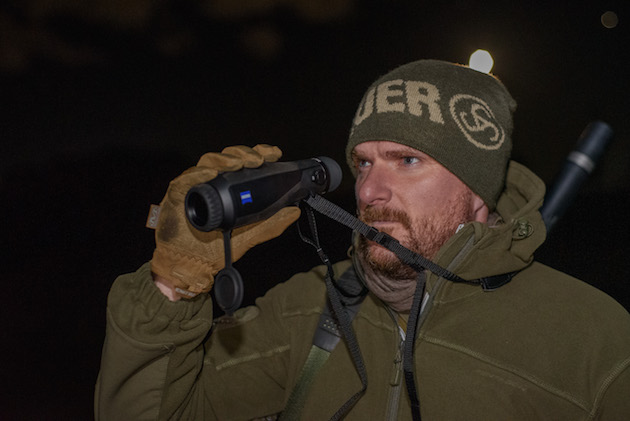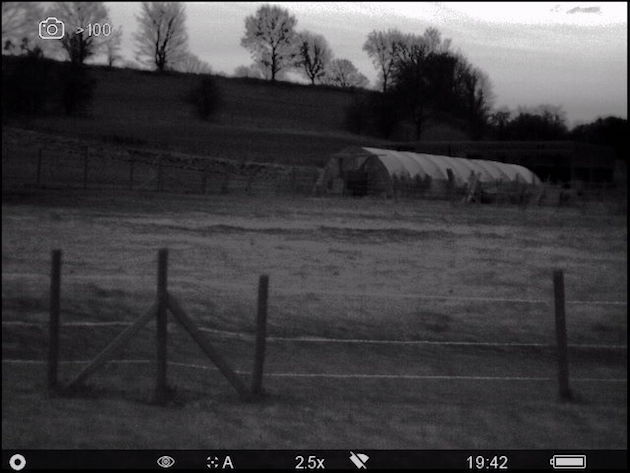20 things to know about the new ZEISS DTI 3/35 monocular
Why the ZEISS DTI 3/35 monocular is a game changer Excellent optics deliver reliable identification even in darkness Device is easy…
Win CENS ProFlex DX5 earplugs worth £1,149 – enter here
 David Land
David Land
Thermal imaging technology shows the heat emitted by a source in clear detail. Anywhere there is a temperature difference is going to reveal a contrasting image via electronic processing.
Daytime use of thermal imagers in dark conditions like woodland, especially with minimal clearance in foliage, allows the tiniest flicker of heat to be detected – you would have missed it with natural eyesight or binoculars.
Looking out across open land in daylight or darkness allows you to count individual animals more quickly as part of a cull quota or management plan. It’s important to remember that anything with a significant thermal difference to the background conditions can reveal itself (sometimes even a buried stone can draw attention) but the increasingly higher resolution sensors are making detail and secondary identification more realistic, as well as primary detection at longer distances.
Shooters suffer increasingly from deliberate and accidental presence of humans loitering where they shouldn’t be. However with thermal, their position is highlighted regardless of camouflage deception. Daylight offers the ability to check clear line of sight for the bullet’s transit to target but sometimes in darkness, quarry like foxes or rats cowering low behind the lightest of cover can become invisible to the naked eye or scope, yet are still obvious with thermal.
In darkness with a thermal riflescope, you can’t always see foliage and other obstructions like fencing wires that may cause a miss or ricochet, so beware. Thermal increases the amount of time you have to assess quarry without alerting anything, especially in darkness where lamps had to be a quick skim at most, so give greater time for consideration and perhaps also a calmer shot. Nothing can be relied upon but as technology advances, it’s important not to think you totally own the darkness, even though with premium equipment like thermal binoculars, it’s incredible how easily immersed you become in what was once complete blackness.
Foxes seem to be the first focus of attention during discussions about thermal imagers in either rifle scope or handheld spotter format. Thermal is a popular way to deal with a predator species most effectively controlled after dark and directly harmful to a broad range of farming and game rearing environments. Foxes are often the most likely species to justify the initial financial investment of thermal imagers, which make them much easier to track and shoot in darkness.
In addition, thermal imagers are extremely useful in finding wounded deer that have sought cover, so that they can be despatched humanely.
The cost of thermal imaging is becoming more appealing at the entry level. In addition, capability at the high end continues to grow incrementally with improving sensors and additional functionality like rangefinders and hot trackers. Smaller pixels on the sensor (and more of them) can lead to improved resolution and detection ranges. However remember that balance is important and just like a day scope, bigger numbers aren’t always better.
Variations across borders affect what can be used in terms of electronic image intensifiers for which thermal and night vision qualify. Scotland does not allow any kind of image intensifying tool for use shooting deer in daylight or darkness although a thermal spotter is permitted. England allow both within regular laws. Pest species like rabbits and rats show great use for thermal imaging but it’s a situation where hares present a very similar hot profile to the former, so the ability to watch the gait of the animal undisturbed allows clearer differentiation even when newer units promise greater detail resolution.
Why the ZEISS DTI 3/35 monocular is a game changer Excellent optics deliver reliable identification even in darkness Device is easy…
In the foxing world, it is rare that a dead fox is not a successful shot but deer demonstrate important variety of sex, body condition and maturity to dictate a good choice for the shot and a thermal rarely gives all the detail to fulfil those requirements. Binoculars and the normal daylight riflescope still have their place solidly enshrined within the sporting world, but don’t just look at thermal as a new trend; it is a serious tool for detection and safety when used correctly as an additional assist.

Thermal riflescopes enable shooting in total darkness without additional infra-red light and often see partially obscured quarry
The thermal spotter has become one of the greatest shooting aids ever invented. Where binoculars could be said to give you better eyes with more magnification, thermal enables a whole new world of observation in total darkness. Although new sensors with smaller pixel size are appealing, ergonomics play an important role in regular use and it’s also worth considering the relevant effects of diminished natural night vision effects from looking at an illuminated display. For long nights of pest control and foxing, I still prefer the binocular units for visual balance but cost increases and detection range is not the only factor to consider.
Get the latest news delivered direct to your door
Discover the ultimate companion for field sports enthusiasts with Shooting Times & Country Magazine, the UK’s leading weekly publication that has been at the forefront of shooting culture since 1882. Subscribers gain access to expert tips, comprehensive gear reviews, seasonal advice and a vibrant community of like-minded shooters.
Save on shop price when you subscribe with weekly issues featuring in-depth articles on gundog training, exclusive member offers and access to the digital back issue library. A Shooting Times & Country subscription is more than a magazine, don’t just read about the countryside; immerse yourself in its most authoritative and engaging publication.

